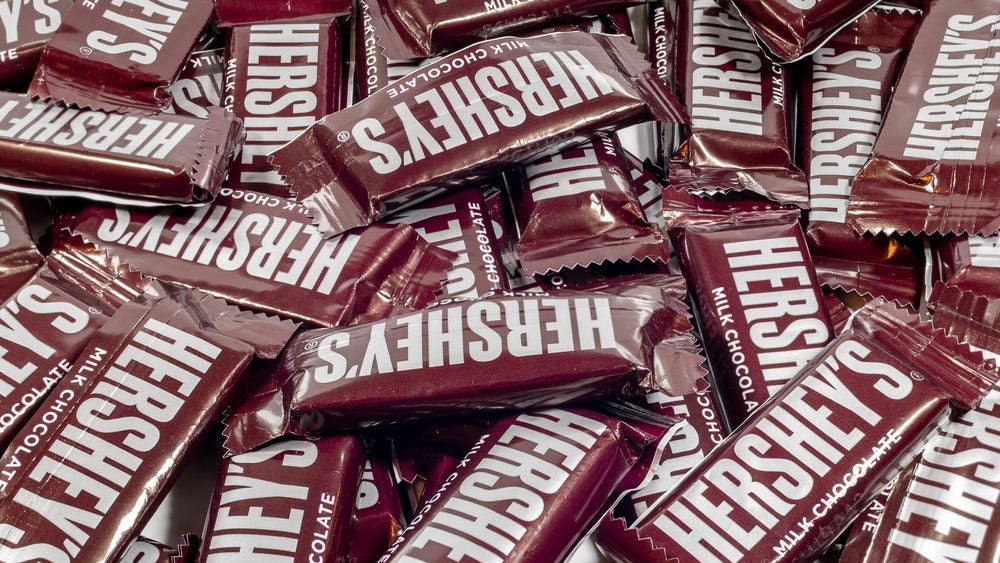Hershey is optimistic cocoa inflation will turn deflationary in 2026 as it also expects a marginally lower tariff impact than previously envisaged for this year.
Tariffs, rising cocoa costs and associated pricing have dogged Hershey, particularly for the group’s largest revenue earner, its North America confectionery division.
The business unit accounted for $2.62bn in sales in the third quarter, compared to the group total of $3.18bn, with organic growth coming in at 5.2% and 6.2%, respectively, Hershey reported yesterday (30 October).
With cocoa prices now coming off their historical highs – but still 70% above levels two years ago – and tariff implications cut by $10m to a range of $160-$170m for the year, Hershey tweaked its fiscal 2025 sales guidance higher.
The Reese’s and Rolo brand owner expects sales to rise by about 3% versus the prior estimate of “at least” 2%. However, earnings per share are still forecast to decline, albeit adjustments have been made to the outlook there.
Reported EPS is likely to be down 48-50%, versus 50% previously, while on an adjusted basis, the metric is now expected to fall by 36-37%, compared to a 36-38% drop.
In terms of cocoa, Hershey’s recently installed new president and CEO Kirk Tanner said: “While we are pleased to see the convergence of our pricing approach with improvement in the commodity markets, based on what we see today, we still have more work to do, as cocoa prices remain up over 70% from 2023 levels.
“We remain committed to our approach to managing cost inflation through all levers over time.”
CFO Steve Voskuil said Hershey is modelling for net price realisation for fiscal 2025 of five to six percentage points but was more positive on the outlook into the new year.
“While cocoa futures have retreated, based on what we know today, we continue to forecast cocoa inflation in 2026. While the long-term outlook is brightening...we will continue to manage through the commodity cost inflation and tariff expenses we’ve absorbed over the last two years, which are not yet fully recovered by recent pricing actions,” Voskuil explained.
Pressed on the analyst call, he added: "For now, we've modelled $200m incremental on tariffs and still have in our model cocoa inflation for next year, but I would say that level of inflation is moderating and we'll know more when we talk next time.
“The expectation right now with where cocoa is, I would hope as we get deeper into ‘26, we'd start to see some deflation. In ’26, we would not anticipate taking more price, even if cocoa remained at prior levels.”
Hershey did lose volumes in confectionery in the third quarter to the tune of a negative one percentage point and positive pricing of seven points.
Volume/mix for the group was flat based on pricing of six points.
Hershey’s second-largest division in terms of sales – North America salty snacks with $321m in Q3 – delivered both sales and volume growth even as the category continues to face consumer pressure in the US from health adjustments and cost-of-living headwinds.
There, organic growth was 10% with a positive volume/mix of 11% and negative pricing of one percentage point.
“I think the consumer certainly is continuing to be challenged. It's a challenging consumer market but I would say our category remains resilient,” CEO Tanner said on the call when questioned on the environment in salty snacks.
“And then as we look into ‘26, we see the category running at historic levels with those pressures. So I feel really confident about where we're at in light of a challenged consumer.”
For Hershey’s remaining division in international with $245m in sales, organic growth was 12.1% in the quarter with volume/mix up 6%, and pricing of seven percentage points.
Voskuil explained the dynamics: “It's a challenging market because a lot of our business in international is cocoa-driven and even cocoa-intense in some markets where the percent of cocoa is part of the advertising. And so, it feels more of the brunt from cocoa.
“We've been more aggressive on pricing in international but because we're a smaller player in some of those markets and our products are positioned in a more premium way, the elasticity impacts are also more severe than what we model here in the US.”









